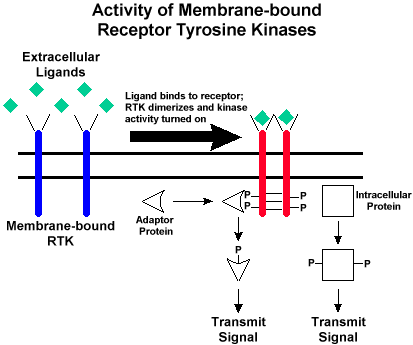
Signaling Control of Transcription
Hormonal Control of Gene Expression
Signal Transduction Pathways
Activation of Transcription Via Signal Transduction Pathways
If the receptor is found in the membrane of the cell, a series of signals must be passed through the membrane to intercellular molecules which in turn activate transcription. This series of signals is called a signal transduction pathway. These pathways often involve the phosphorylation of the receptor protein which in turn phosphorylates other cellular proteins This signal is passed through the several cellular protein where eventually a transcription factor is modified such that it activates transcription.
Receptor kinases are a class of membrane bound that can act as a receptor protein. Kinases are proteins with the ability to phosphorylate (add phospate groups) other protein. A tyrosine kinase would add a phosphate group to tyrosine residue. Receptor tyrosine kinases (RTK) are one type of membrane bound proteins that are activated when a ligand binds to its extracellular ligand binding site. Another kinase class is a serine-threonine kinase that phosphorylates a serine or threonine.
When the kinase binds the extracellular ligand, it undergoes a dimerization in the membrane. This dimerization in turn activates the phosphorylation function of kinase. When activated, the kinase enzyme first autophosphoryates appropriate amino acids in its intracellular domain. Once the kinase is phosphorylated, docking or adaptor proteins can bind to the phosphorylated site which activates the bound proteins which allows the signal to be further transmitted through the cell. Alternatively, the receptor protein can use its phosphorylation activity to modify another intracellular protein by the addition of a phosphate group. This protein can be the beginning of the signalling pathway that eventually results in the activation of transcription. The figure below illustrates the process.

G-protein is an example of a protein that can receive an activation signal in a signal transduction pathway. G-proteins can bind either GDP or GTP. The protein is inactive when GDP is bound and active when GTP is bound. The transition from GDP to GTP binding is mediated by a protein that is activated by its interaction with docking proteins. The activated G-protein next binds to cytoplasmic protein kinase which activates the kinase's phosphorylation activity. The kinase can then send a signal via phosphorylation. The final step would be the activation of transcription via a nuclear transcription factor.
Copyright © 1997. Phillip McClean